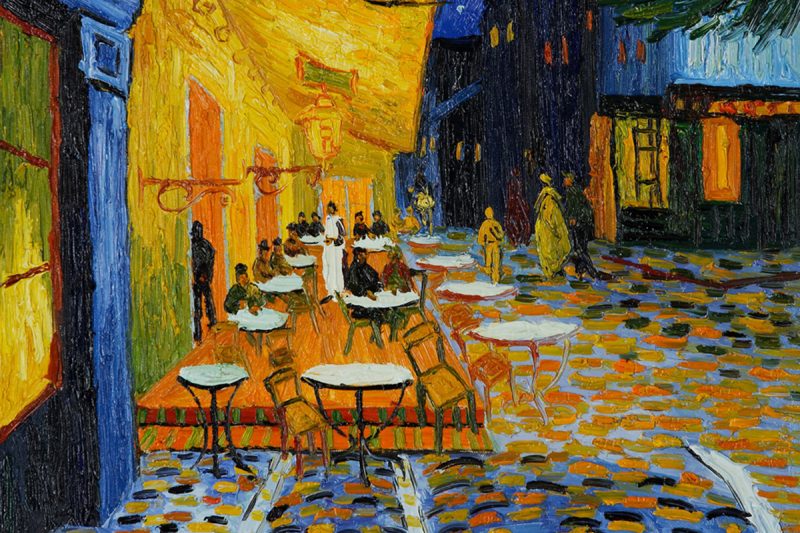
In 1888, Vincent van Gogh painted Café Terrace at Night during his stay in Arles. It’s oil on canvas, about 32 x 25 in (81 x 65 cm). It is part of the Kröller-Müller museum collection. Other names it goes by are Café Terrace on the Place du Forum, Café at Night, or simply Night Café. Van Gogh wrote about painting the Café Terrace at Night to his younger sister Willemien; the letter offers some insights in what he thought while he painted it. He compared the scene in the painting to the beginning passage in the book Bel-Ami by Guy de Maupassant, stating that it was a good approximation of what he aimed to paint.

As was well known about Van Gogh, he enjoyed walking to locations to paint on site. With this painting, he went to the café at night to do this job. He described the process in the letter, “I enormously enjoy painting on the spot at night. In the past they used to draw, and paint the picture from the drawing in the daytime. But I find that it suits me to paint the thing straightaway. It’s quite true that I may take a blue for a green in the dark, a blue lilac for a pink lilac, since you can’t make out the nature of the tone clearly. But it’s the only way of getting away from the conventional black night…” His goal was to bring to life a night painting that uses “nothing but beautiful blue, violet and green.” Looking at the painting proves this is true. Black is not used for the night sky or even the shadowed buildings. Instead it is used to create the cobblestones and some of the figures, reducing them to minor details of the painting. Van Gogh found that only by being there could he capture the true colors he saw in the moment.
The real focus for the eyes is the contrast of the lantern-lit café and the sky. The bright yellow that Van Gogh devoted to the light of the lantern makes it as bright and friendly as sunlight. The light is so bright that it is difficult to make out the shape of the lantern it comes from, much like looking directly at the sun. Its cheeriness draws the people in the painting in, similar to how sunflowers turn up to the sun. The darkness of the blues and greens on the buildings in the background only seem to highlight how the people are lured into the light of the café. He takes care to blend the yellow into the walls of the immediate building, the cushions of the chairs, the tables, the ground. It gives a sense of warm summer nights in Southern France, sipping at a drink and relaxing as the hours while away. It even brightens up the sky, colored a rich indigo, pocked by yellow globules of paint for stars. The yellow from the café and the stars make the night seem alive, blending the two together. It is waiting to see how the night unfolds.
Van Gogh captures the textures of the night scene with his keen brushstrokes. The cobblestones are lumps on the ground ready to bounce the carriage approaching the café from the background. The walls and the awning are smooth, languid strokes. The fronds of the tree at the right of the foreground practically bristle off the canvas into the viewer’s space. He wisps swirls of white paint along the edges of the buildings and sky, giving the impression of clouds.
Between his use of color and his manipulation of the paintbrush, Vincent van Gogh gives captures a moment, an anecdote about about a night at an Arlesian café. He translates the energy that he sees, feels from this single moment into brilliant art ready to touch the world for ages.
Sources:
